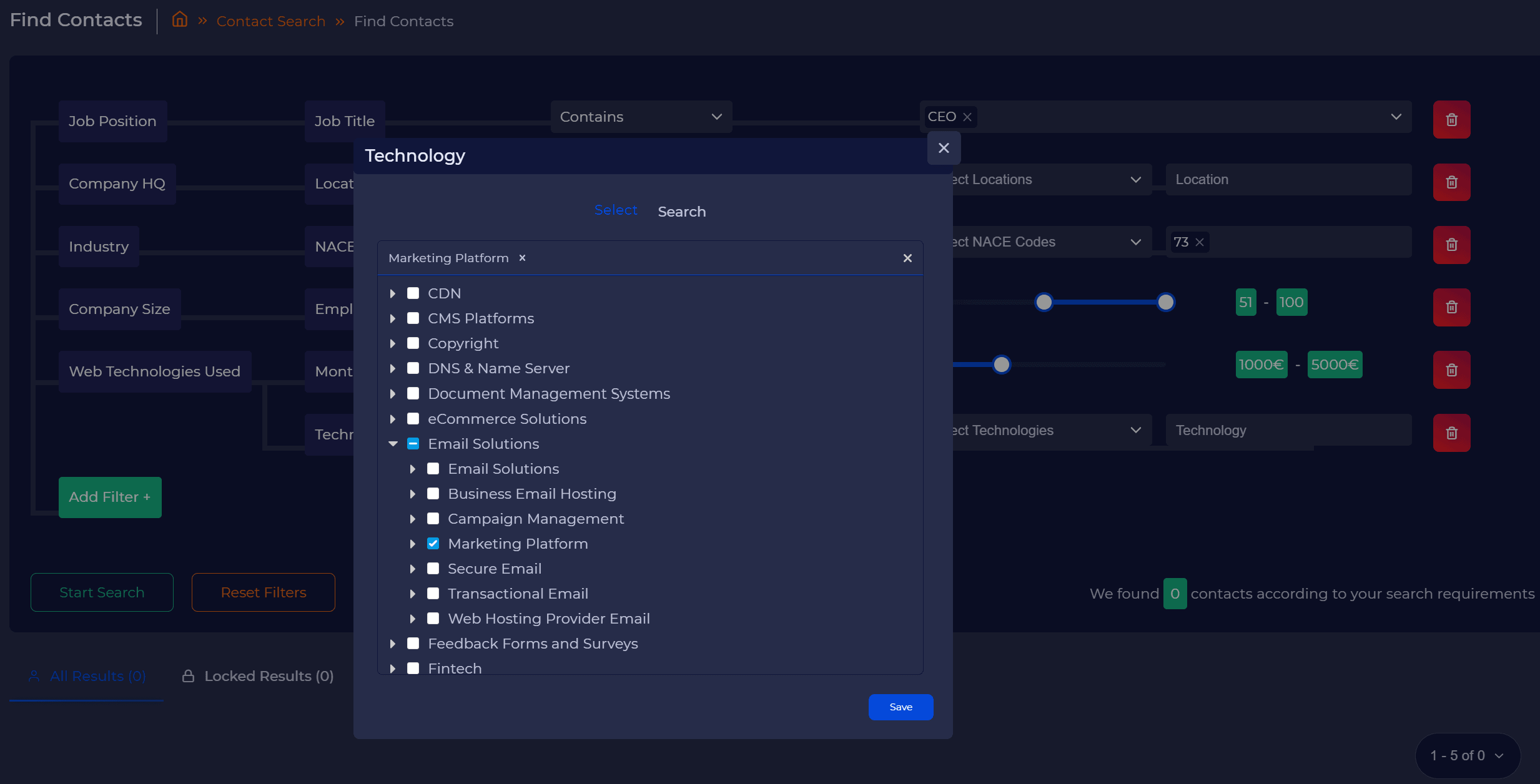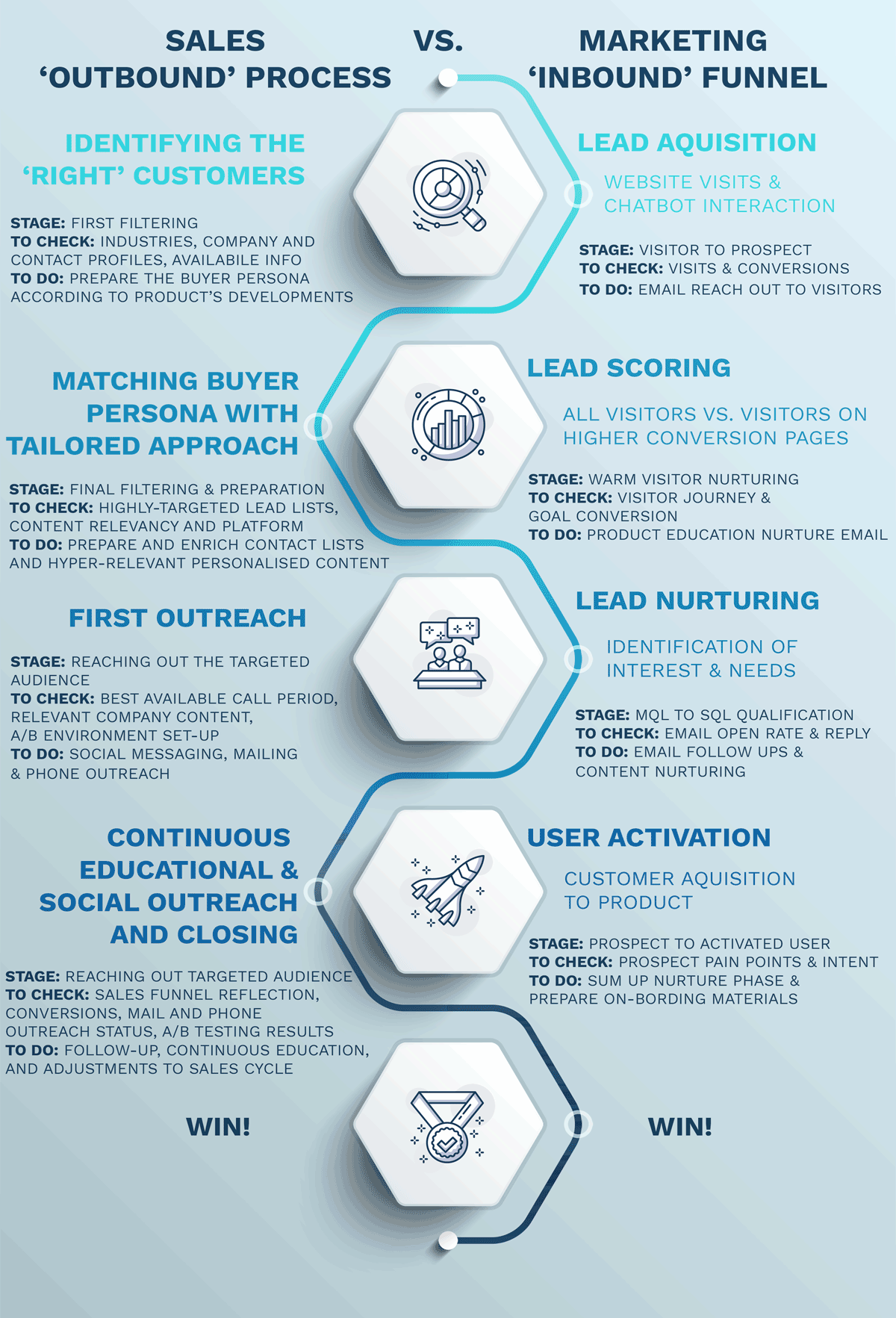Updated on September 1, 2021
Inbound vs. Outbound. Should you focus your sales team to reach out to potential clients or direct them to engage with and nurture existing clients and high value potential leads?
Are you new in the sales game? Or, are you an experienced salesperson?
Either way, sales is not that easy!
Empathy, creativity, discipline, confidence, competitiveness and willingness to learn are just some of the skills needed. No wonder there is always a massive demand for high-quality salespeople.
So, what should you do to stand out? How can you become a top sales performer?
It is all about the process.
Inbound vs. Outbound
Not that long ago, sales used to be all about cold approach and pitching to prospects (outbound). Nowadays, we make customers come to us (inbound).
In the next few minutes, you will learn the tactics and strategies of how Sales.Rocks managed to start digital transformation in the sales processes by using both outbound and inbound approach.
The New Kind Of Outbound
A 100% outbound approach used to involve going out into the market and putting your best effort to generate interest from scratch. It was all about generating cold leads and hoping that some of them will have any interest in your product.
Things changed. Sales teams do not prospect blindly anymore. Instead, they are looking for leads based on very specific requirements that will match their identified ideal customer. At Sales.Rocks having an accurate and reliable buyer personas are our keys to accurate prospecting.
The outbound process is carried by our Sales Development Representatives.
Step 1: Identifying The Right Customers
The first step is using a tool to filter the target audience. We use the Sales.Rocks Company Search internally for this to select only the leads that are valuable for us.
Finding the right target customers can be done using company info, contact info but also technographics a company is using.

Step 2: Matching Buyer Persona With Tailored Approach
When creating a list of companies for reaching out, you need to check out the company’s website and social profiles of the decision-makers to get a better insight into the main activities, concerns and difficulties the companies may have. These insights helps you prepare the buyer persona and match it with a tailored approach.
From the filtered companies, develop a highly-targeted lead list and relevant and hyper-personalized content for the first outreach.
For example, if using the Sales.Rocks Company Search Module, primarily choose the country where you want to focus your efforts to. To narrow the search, check out the list of NACE codes and choose the one that works for you. This will help you pick an industry where your solution will be beneficial.
Company size and company status filters can make your researching process more detailed because it shows you whether is a start up, small to medium or enterprise business. Moreover, if you know the year when the business was founded, this will help you tailor the content according to their pain points.
Just as it is important to understand your targeted audience, it is also essential to know the technology and applications they use in their everyday business practice so you can make your solution stand out. You can achieve this with the Web Technologies used filter.
Using this criteria, sales representatives can find companies by technology stack they use on their websites (e.g. WordPress, Joomla, Laravel, JavaScript, etc). This allows them to be prepared with insights on what technology their lead is using so they don’t waste time reaching out to leads that are not qualified.
Last, but not least, depending on the way you want to do your outreach, tick the boxes of Phone, Email and Website available.
All the data you will receive as an output will be a good start to create highly personalized email, or even a sales call with tailored questions for the client.
Step 3: First Outreach
Next, you are ready to reach out to our targeted audience. Do a final check of the company details. After tailoring and sending the initial outreach which consists of an educational email, make sure to choose the best available period to reach them by phone.
You can use multiple channels, but our focus is on direct emails, phone calls, and Linkedin outreach. This includes A/B testing on several approaches to see what works and what doesn’t.
During the outreach, it is a good practise to ask targeted and open-ended questions and listen carefully to what a prospect says to us so we tailor the solution accordingly. We are not directly selling the platform, but rather allowing them to test it and go through the buying process with convenience.
Step 4: Continuous Educational & Social Outreach And Closing
As you are slowly driving them into the bottom of the sales funnel, continue the process of nurturing and educating the customers on how our B2B platform can be beneficial for their business growth.
On The Other Hand, How Do We Nail Our Inbound Approach?
The inbound approach involves a bit more of a marketing touch. Over the last year, the marketing team has expanded their inbound marketing roles.
Step 1: Lead Acquisition
In every marketing team, you need a dedicated team member to reach out quickly to inbound requests with appropriate qualifying questions. It involves reaching out to those warm leads who are already engaging with your content, who are genuinely interested in your product and register for trying out your solution without any additional qualification needed.
The reach out is done via email. You should get in touch with them and find out if they are struggling with their sales prospecting process. Are they in need to generate more highly-targeted B2B leads for their sales funnels?
For example, if they have visited your website, had an interaction with the chatbot or they are returning visitors are clear indicators that the lead has already past the awareness stage. When it comes to landing page visits, if they visited the product page or the pricing page, take an inbound action and tailor the pitch according to their activity.
Step 2: Lead Scoring
In the case of returning visitors, start with email outreach. For those who open the email, message them for the second time. This prospect email activity is easy to track with email automated software like Zoho CRM, Microsoft Dynamic CRM, etc.
The Marketing Development Representative keeps in touch with those leads to make sure that they maximize their results from visiting our website, using our platform or the piece of content they just read or downloaded. Moreover, the MDR makes sure to meet the needs of the visitors who use the chatbot as a touchpoint and offer them an appropriate solution for their pain points.
The MDRs job is to identify whether they are sales qualified leads (SQL) which is often indicated by which actions a prospect takes that indicate the intention to buy. This classification depends on the website activity, platform interaction or responses to marketing materials.
Step 3: Lead Nurturing
Content matters! We care to provide our potentials with valuable content, what will one one hand educate them about Sales.Rocks, how to use it, what it’s benefits and what’s up-coming. On the other hand, it is always a good idea to share company’s practices, experiences, insight of processes, so that the prospect can learn how to implement data-driven processes in their business.
Step 4: User Activation
The objective here is to drive engagement with a product (in this case the Sales.Rocks platform), such as prospects signing up to try the Freemium version of the platform, or just simply read a valuable piece of content our Content writer produced.

So, inbound vs. outbound which is better?
Cold outbound was the only real strategy a decade ago.
In recent years, the birth of content marketing made the inbound approach a more effective strategy that has dramatically grown in popularity.
What should you focus on? Inbound vs. outbound approach? Or both?
Inbound strategies are in-style nowadays, but what about the long-term result? Inbound leads are not in our direct control and they tend to reach a steady rate. In parallel, with so much info at the click of the mouse, it is a tough job to actively focus on investigating and pursuing the most relevant leads. As experts have a tendency to say: Inbound is reacting, outbound is acting.
At Sales.Rocks, we believe that inbound plus outbound equals long-term SaaS success. For example, we use both approaches, cold outbound, and warm inbound. New companies, especially new start-ups can benefit most from using outbound methodologies and strengthen their sales efforts by using inbound strategies.
Basically, what we tend to do with both approaches is not just selling a product to the client, but to educate them. Instead of being the typical Salespeople, we tend to be consultants. Our main point is to make sure the client identifies their weaknesses and find a solution in our product. We want to create a long-lasting relationship with our customers, for which we need to ensure that our product covers our clients’ needs and add some values that our competitors are not able to do.
So, whatever method you choose to be the focus of your sales process, make sure to get the best of both worlds!
The Ultimate Guide to Sales Prospecting
Find out how Inbound vs Outbound fits in the bigger picture of successful prospecting for sales.


